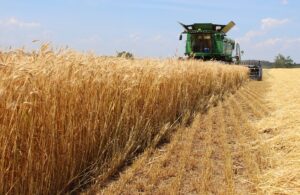Menu
Pushing Wheat Yields Higher
As we turn the calendar page to March and winter turns to spring, one of the first crops we focus on is wheat acres.
There are three critical decision points in successfully growing high-yield wheat: Planting (seed genetics, seeding rate, stand establishment, and fall weed control), Nutrient Management (fall fertility, nitrogen management, and pushing the yield to the finish), and Pest Pressure (season-long disease control, controlling head scab to protect grain quality and insect protection).
PLANTING—the first critical decision is already behind us. Important considerations included choosing the best genetics available, planting the proper seeding rate to reach our goal, and managing foundational fall fertility.
Let’s look at how we did. Are you out walking your fields now? What do your stands look like? High-yield wheat will require 25–40 plants per square foot, and hopefully, by now, we have established five or more fillers per plant. Here’s where genetics may show variability. Some varieties tiller better than others, so for those varieties that tiller less, we recommend pushing up the seeding rates to achieve the number of heads required to promote maximum yield.
Yields above 100 bushels per acre need 60–80 heads per square foot. If we are successful with our fertility program, each mature head per square foot can represent 1.2–1.5 bushels per acre. You can do the math: 60 mature heads can push yields to 120 bu/A, etc.

NUTRIENT MANAGEMENT—the second critical decision point is right before us. Hopefully, we’ve checked out pH, applied lime if needed, and applied 15 units or so of nitrogen in the fall with a little sulfur, and now we’re ready to set the crop up for maximum nutrient uptake and higher yields.
How many nitrogen applications are you planning? If you intend just one application, we certainly recommend applying N with a nitrogen stabilizer like N-Ergize, along with CarbonMaxx at the rate of 1 pt/per 50 units of applied nitrogen. Up to 25% of the UAN solution applied is in the form of ammonia, which contributes to leaf burn. The CarbonMaxx product helps to arrest the ammonia in the UAN, reducing the leaf tissue burn.
Many growers prefer to split-apply nitrogen, which we recommend. The first application is applied at green-up in the spring. With this application, we are trying to enhance the tillering during the early growth stages. Time the second application close to Feekes 5–6 to provide adequate nitrogen for maximum plant uptake during vegetative and grain-fill stages of growth. Consider using a growth regulator on these high-yield acres to prevent lodging while pushing for the highest yields.
High fertility is not the only contributing factor to potential lodging issues. Crown rots and other diseases like Strawbreaker, also known as Eye Spot can be problematic in parts of the Mid-Atlantic region. Fall-applied fungicides that control Strawbreaker have proven effective in managing this disease. The primary infection of Strawbreaker starts on or near the soil surface, affecting the coleoptile or base of the plant, and can contribute to significant lodging issues, especially in high-yield soils.
PEST PRESSURE—the third critical decision point is the management of diseases and insects. Again, we are past the decision point for the fall programs, and now our focus is on managing powdery mildew, leaf rusts, leaf blotches, and getting good head scab control. Not every disease is yield-limiting annually, but careful management and prevention of these diseases are vital to maximize yields and preserve grain quality. We usually look at fungicides as the critical ingredient for disease control. Still, we don’t forget the importance of balanced and adequate nutrition to enhance the plant’s capacity to defend itself against those pathogens. Aphids, cereal leaf beetles, and other pests must be scouted for and controlled.
What are some of the key nutrient drivers in high-yielding wheat? Nitrogen is essential but don’t overlook phosphorus. Potassium, calcium, sulfur, zinc, boron, copper, and molybdenum are all necessary for high yields.
___________________________________________________________________________________________
Here at PowerAG we can help you with crop protection and nutrient needs recommendations. CarbonMaxx, N-Ergize, BorPower, AlphaPower MP, KwikPower, and DynaMino are all products that can be tailored to your wheat crop needs. Talk with your PowerAG sales rep to achieve your high-yield goals.


